12 3.1 Ionic and Molecular Compounds
Learning Objectives
By the end of this section, you will be able to:
- Define ionic and molecular (covalent) compounds
- Predict the type of compound formed from elements based on their location within the periodic table
- Learn the characteristic charges that ions of many elements have
- Determine formulas for simple ionic compounds
The law of conservation of matter tells us that the identity of atoms does not change during chemical reactions. However the connections, or bonds, between atoms in molecules and compounds can and does change. These changes involve the electrons surrounding the atomic nuclei. Electrons can be added to atoms by transfer from other atoms, lost by transfer to other atoms, or shared with other atoms.
Ion formation
During the formation of some compounds, atoms gain or lose electrons, and form electrically charged particles called ions (Figure 1).
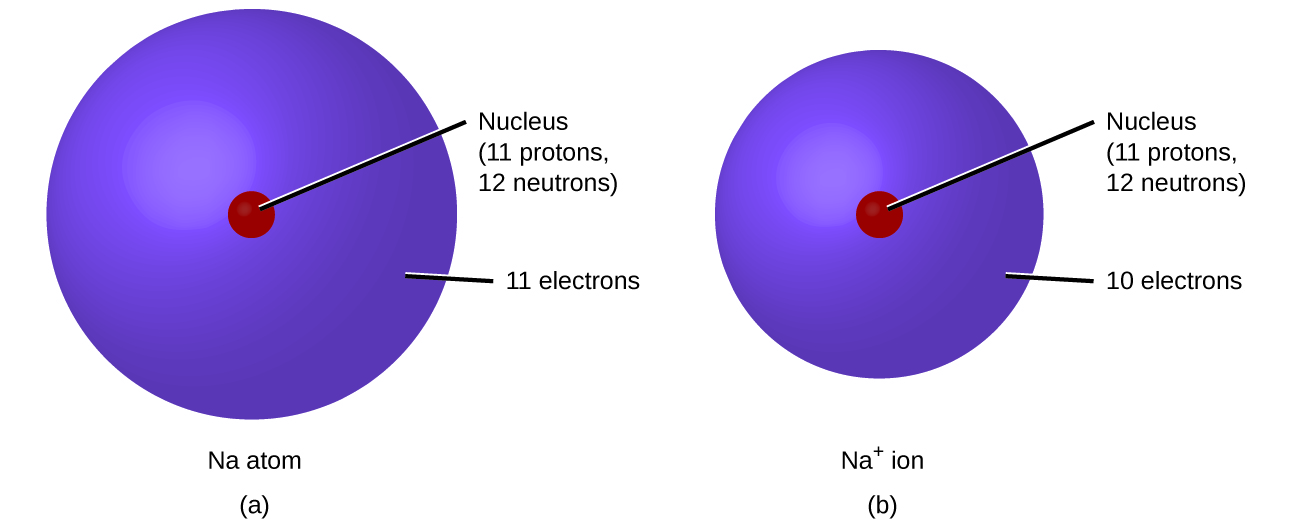
You can use the periodic table to predict whether an atom will form a negatively-charged anion or a positively-charged cation, and you can often predict the charge of the resulting ion. Atoms of many main-group metals lose enough electrons to leave them with the same number of electrons as an atom of the preceding noble gas. For many common elements this corresponds with an electron configuration that has the valence shell of electrons at capacity.
To illustrate, a Group 1 metal loses one electron and forms a cation with a 1+ charge; and a Group 2 metal loses two electrons and forms a cation with a 2+ charge. For example, a neutral calcium atom, with 20 protons and 20 electrons, readily loses two electrons. This results in a cation with 20 protons, 18 electrons, and a 2+ charge. As an ion it now has the same number of electrons as atoms of the preceding noble gas, argon, and is symbolized Ca2+. The name of a metal cation is the same as the name of the metal atom from which it forms, so Ca2+ is called a calcium ion.
When atoms of nonmetal elements form ions, they generally gain enough electrons to give them the same number of electrons as an atom of the next noble gas in the periodic table. Atoms of group 17 gain one electron and form anions with a 1− charge; atoms of group 16 gain two electrons and form ions with a 2− charge, and so on. For example, the neutral bromine atom, with 35 protons and 35 electrons, can gain one electron to provide it with 36 electrons. This results in an anion with 35 protons, 36 electrons, and a 1− charge. It has the same number of electrons as atoms of the next noble gas, krypton, and is symbolized Br−.
Note the usefulness of the periodic table in predicting likely ion formation and charge (Figure 2). Moving from the far left to the right on the periodic table, main-group elements tend to form cations with a charge equal to the group number. That is, group 1 elements form 1+ ions; group 2 elements form 2+ ions, and so on. Moving from the far right to the left on the periodic table, elements often form anions with a negative charge equal to the number of groups moved left from the noble gases. For example, group 17 elements (one group left of the noble gases) form 1− ions; group 16 elements (two groups left) form 2− ions, and so on. This trend can be used as a guide in many cases, but its predictive value decreases when moving toward the center of the periodic table. In fact, transition metals and some other metals often exhibit variable charges that are not predictable by their location in the table. For example, copper can form ions with a 1+ or 2+ charge, and iron can form ions with a 2+ or 3+ charge.
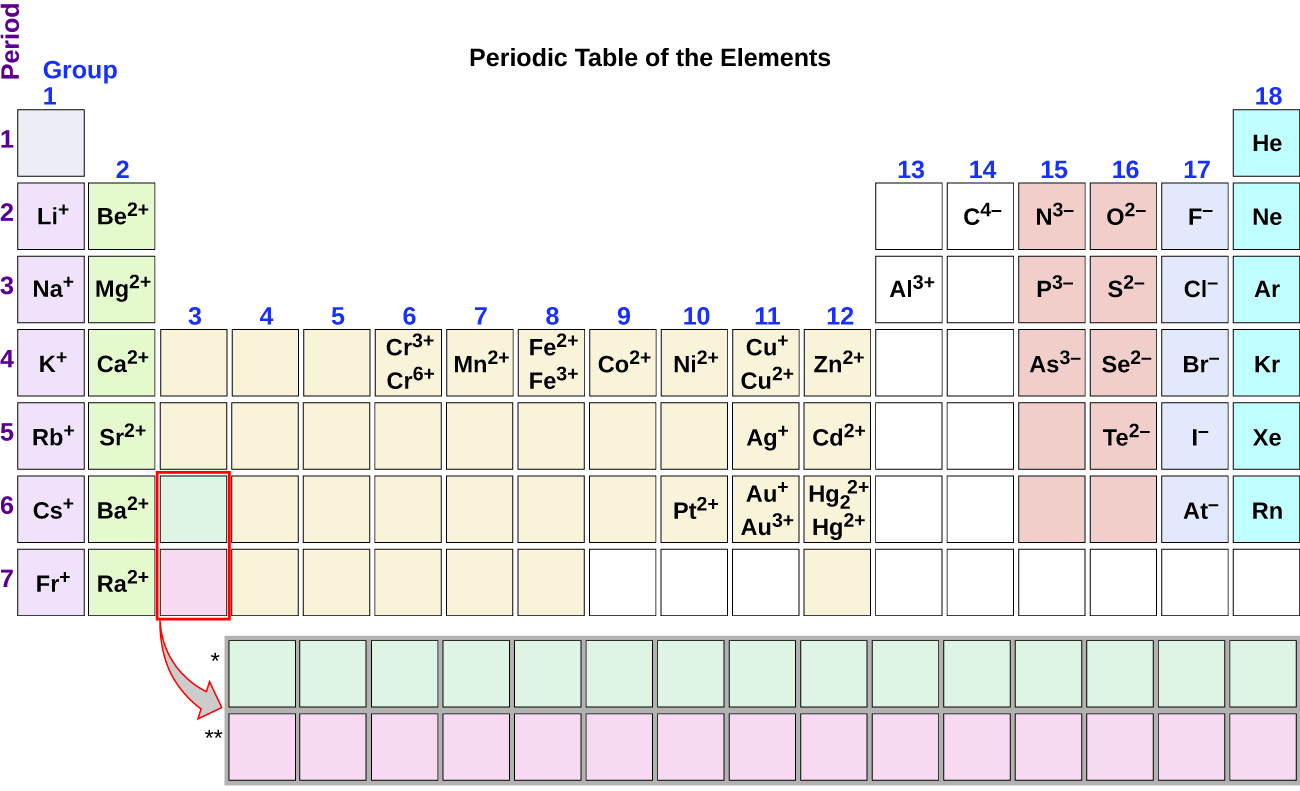
Example 1
An ion found in some compounds used as antiperspirants contains 13 protons and 10 electrons. What is its symbol?
Solution
Because the number of protons remains unchanged when an atom forms an ion, the atomic number of the element must be 13. Knowing this lets us use the periodic table to identify the element as Al (aluminum). The Al atom has lost three electrons and thus has three more positive charges (13) than it has electrons (10). This is the aluminum cation, Al3+.
Test Yourself
Give the symbol and name for the ion with 34 protons and 36 electrons.
Answer
Se2−, the selenide ion
Example 2
Magnesium and nitrogen react to form an ionic compound. Predict which forms an anion, which forms a cation, and the charges of each ion. Write the symbol for each ion and name them.
Solution
Magnesium’s position in the periodic table (group 2) tells us that it is a metal. Metals form positive ions (cations). A magnesium atom must lose two electrons to have the same number electrons as an atom of the previous noble gas, neon. Thus, a magnesium atom will form a cation with two fewer electrons than protons and a charge of 2+. The symbol for the ion is Mg2+, and it is called a magnesium ion.
Nitrogen’s position in the periodic table (group 15) reveals that it is a nonmetal. Nonmetals form negative ions (anions). A nitrogen atom must gain three electrons to have the same number of electrons as an atom of the following noble gas, neon. Thus, a nitrogen atom will form an anion with three more electrons than protons and a charge of 3−. The symbol for the ion is N3−, and it is called a nitride ion.
Test Yourself
Aluminum and carbon react to form an ionic compound. Predict which forms an anion, which forms a cation, and the charges of each ion. Write the symbol for each ion and name them.
Answers
Al will form a cation with a charge of 3+: Al3+, an aluminum ion. Carbon will form an anion with a charge of 4−: C4−, a carbide ion.
The ions that we have discussed so far are called monatomic ions, that is, they are ions formed from only one atom. There are also many polyatomic ions found in nature. These ions, which act as discrete units, are electrically charged molecules (a group of bonded atoms with an overall charge). Some of the more important polyatomic ions are listed in Table 1. Oxyanions are polyatomic ions that contain one or more oxygen atoms.
Note that there is a system for naming some polyatomic ions; -ate and -ite are suffixes designating polyatomic ions containing more or fewer oxygen atoms. This system quickly becomes complex, and is not easily connected to principles you have learned, so unless or until you will use chemistry names frequently it is not necessary to fully understand.
| Name | Formula | Related Acid | Formula |
|---|---|---|---|
| ammonium | [latex]\text{NH}_4^{\;\;+}[/latex] | ||
| hydronium | [latex]\text{H}_3\text{O}^{+}[/latex] | ||
| oxide | [latex]\text{O}_2^{\;\;-}[/latex] | ||
| peroxide | [latex]\text{O}_2^{\;\;2-}[/latex] | ||
| hydroxide | [latex]\text{OH}^{-}[/latex] | ||
| acetate | [latex]\text{CH}_3\text{COO}^{-}[/latex] | acetic acid | [latex]\text{CH}_3\text{COOH}[/latex] |
| cyanide | [latex]\text{CN}^{-}[/latex] | hydrocyanic acid | [latex]\text{HCN}[/latex] |
| azide | [latex]\text{N}_3^{\;\;-}[/latex] | hydrazoic acid | [latex]\text{HN}_3[/latex] |
| carbonate | [latex]\text{CO}_3^{\;\;2-}[/latex] | carbonic acid | [latex]\text{H}_2\text{CO}_3[/latex] |
| bicarbonate | [latex]\text{HCO}_3^{\;\;-}[/latex] | ||
| nitrate | [latex]\text{NO}_3^{\;\;-}[/latex] | nitric acid | [latex]\text{HNO}_3[/latex] |
| nitrite | [latex]\text{NO}_2^{\;\;-}[/latex] | nitrous acid | [latex]\text{HNO}_2[/latex] |
| sulfate | [latex]\text{SO}_4^{\;\;2-}[/latex] | sulfiric acid | [latex]\text{H}_2\text{SO}_4[/latex] |
| hydrogen sulfate | [latex]\text{HSO}_4^{\;\;-}[/latex] | ||
| sulfite | [latex]\text{SO}_3^{\;\;2-}[/latex] | sulfurous acid | [latex]\text{H}_2\text{SO}_3[/latex] |
| hydrogen sulfite | [latex]\text{HSO}_3^{\;\;-}[/latex] | ||
| phosphate | [latex]\text{PO}_4^{\;\;3-}[/latex] | phosphoric acid | [latex]\text{H}_3\text{PO}_4[/latex] |
| hydrogen phosphate | [latex]\text{HPO}_4^{\;\;2-}[/latex] | ||
| dihydrogen phosphate | [latex]\text{H}_2\text{PO}_4^{\;\;-}[/latex] | ||
| phosphite | [latex]\text{PO}_3^{\;\;3-}[/latex] | phosphorous acid | [latex]\text{H}_3\text{PO}_3[/latex] |
| hydrogen phosphite | [latex]\text{HPO}_3^{\;\;2-}[/latex] | ||
| dihydrogen phosphite | [latex]\text{H}_2\text{PO}_3^{\;\;-}[/latex] | ||
| perchlorate | [latex]\text{ClO}_4^{\;\;-}[/latex] | perchloric acid | [latex]\text{HClO}_4[/latex] |
| chlorate | [latex]\text{ClO}_3^{\;\;-}[/latex] | chloric acid | [latex]\text{HClO}_3[/latex] |
| chlorite | [latex]\text{ClO}_2^{\;\;-}[/latex] | chlorous acid | [latex]\text{HClO}_2[/latex] |
| hypochlorite | [latex]\text{ClO}^{-}[/latex] | hypochlorous acid | [latex]\text{HClO}[/latex] |
| chromate | [latex]\text{CrO}_4^{\;\;2-}[/latex] | chromic acid | [latex]\text{H}_2\text{Cr}_2\text{O}_4[/latex] |
| dichromate | [latex]\text{Cr}_2\text{O}_7^{\;\;2-}[/latex] | dichromic acid | [latex]\text{H}_2\text{Cr}_2\text{O}_7[/latex] |
| permanganate | [latex]\text{MnO}_4^{\;\;-}[/latex] | permanganic acid | [latex]\text{HMnO}_4[/latex] |
| Table 1. Common Polyatomic Ions | |||
The nature of the attractive forces that hold atoms or ions together within a compound is the basis for classifying chemical bonding. When electrons are transferred and ions form, ionic bonds result. Ionic bonds are electrostatic forces of attraction, that is, the attractive forces experienced between objects of opposite electrical charge.
Ionic Bonds, Ionic Compounds
When an element composed of atoms that readily lose electrons (a metal) reacts with an element composed of atoms that readily gain electrons (a nonmetal), a transfer of electrons usually occurs, producing ions. The compound formed by this transfer is stabilized by the electrostatic attractions (ionic bonds) between the ions of opposite charge present in the compound.
For example, when each sodium atom in a sample of sodium metal (group 1) gives up one electron to form a sodium cation, Na+, and each chlorine atom in a sample of chlorine gas (group 17) accepts one electron to form a chloride anion, Cl−, the resulting compound, NaCl, is composed of sodium ions and chloride ions in the ratio of one Na+ ion for each Cl− ion. Similarly, each calcium atom (group 2) can give up two electrons and transfer one to each of two chlorine atoms to form CaCl2, which is composed of Ca2+ and Cl− ions in the ratio of one Ca2+ ion to two Cl− ions.
A compound that contains ions and is held together by ionic bonds is called an ionic compound. The periodic table can help us recognize many of the compounds that are ionic: When a metal is combined with one or more nonmetals, the compound is usually ionic.
Ionic compounds tend to have similar general properties. Ionic compounds are solids that typically melt at high temperatures and boil at even higher temperatures. For example, sodium chloride melts at 801 °C and boils at 1413 °C. Compare this with water, a compound that is not ionic and melts at 0 °C and boils at 100 °C. In solid form, an ionic compound is not electrically conductive but it will conduct electricity when molten because its ions are able to move freely through the liquid (Figure 3).
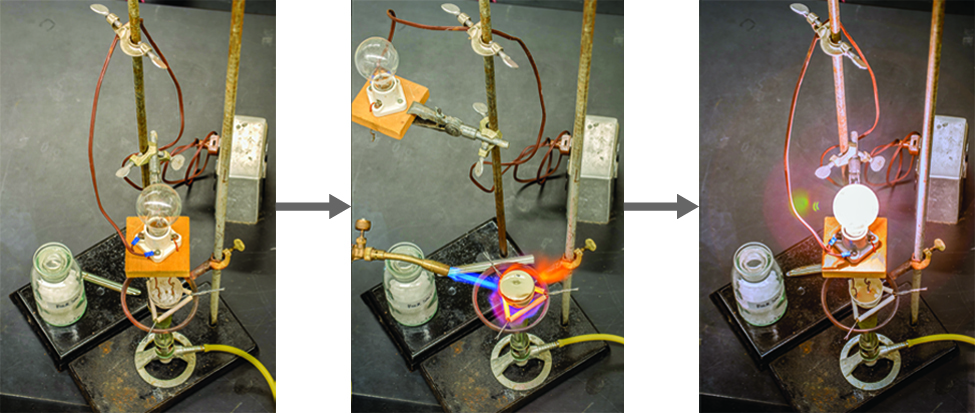
In every ionic compound, the total number of positive charges of the cations equals the total number of negative charges of the anions. Thus, ionic compounds are electrically neutral overall, even though they contain positive and negative ions. We can use this observation to help us write the formula of an ionic compound. The formula of an ionic compound must have a ratio of ions such that the numbers of positive and negative charges are equal.
Example 3
The gemstone sapphire (Figure 4) is mostly a compound of aluminum and oxygen that contains aluminum cations, Al3+, and oxygen anions, O2−. What is the formula of this compound?
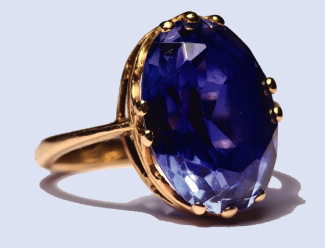
Solution
Because the ionic compound must be electrically neutral, it must have the same number of positive and negative charges. Two aluminum ions, each with a charge of 3+, would give us six positive charges, and three oxide ions, each with a charge of 2−, would give us six negative charges. The formula would be Al2O3.
Test yourself
Predict the formula of the ionic compound formed between the sodium cation, Na+, and the sulfide anion, S2−.
Answer Na2S
Many ionic compounds contain polyatomic ions (Table 1) as the cation, the anion, or both. As with simple ionic compounds, these compounds must also be electrically neutral, so their formulas can be predicted by treating the polyatomic ions as discrete units. We use parentheses in a formula to indicate a group of atoms that behave as a unit. For example, the formula for calcium phosphate, one of the minerals in our bones, is Ca3(PO4)2. This formula indicates that there are three calcium ions (Ca2+) for every two phosphate (PO43−) groups. The PO43− groups are discrete units, each consisting of one phosphorus atom and four oxygen atoms, and having an overall charge of 3−. The compound is electrically neutral, and its formula shows a total count of three Ca, two P, and eight O atoms.
Example 4
Baking powder contains calcium dihydrogen phosphate, an ionic compound composed of the ions Ca2+ and H2PO4−. What is the formula of this compound?
Solution
The positive and negative charges must balance, and this ionic compound must be electrically neutral. Thus, we must have two negative charges to balance the 2+ charge of the calcium ion. This requires a ratio of one Ca2+ ion to two H2PO4− ions. We designate this by enclosing the formula for the dihydrogen phosphate ion in parentheses and adding a subscript 2. The formula is Ca(H2PO4)2.
Test Yourself
Predict the formula of the ionic compound formed between the lithium ion and the peroxide ion, O22− (Hint: Use the periodic table to predict the sign and the charge on the lithium ion.)
Answer
Li2O2
Because an ionic compound is not made up of single, discrete molecules, we don't describe it symbolically with a molecular formula. Instead, ionic compounds are described as a formula unit, a formula indicating the relative numbers of its constituent ions. For compounds containing only monatomic ions (such as NaCl) and for many compounds containing polyatomic ions (such as CaSO4), these formulas are just the empirical formulas introduced earlier in this chapter.
Covalent Bonds, Molecular Compounds
When electrons are “shared” and molecules form, covalent bonds connect the atoms. Covalent bonds are the attractive forces between the positively charged nuclei of the bonded atoms and one or more pairs of electrons that are located between the atoms.
Many compounds do not contain ions but instead consist solely of discrete, neutral molecules. These molecular compounds (also commonly called covalent compounds) result when atoms share, rather than gain and/or lose electrons. We can often recognize molecular compounds based on their physical properties. Under normal conditions, molecular compounds are often gases, low-boiling liquids, and low-melting solids, although many important exceptions exist.
Whereas ionic compounds are usually formed when a metal and a nonmetal combine, covalent compounds are usually formed by a combination of nonmetals. Thus, the periodic table can help us recognize many of the compounds that are covalent if we have access to a chemical formula.
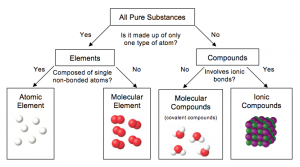
Figure 5. Classification of Pure Substances. Examples include atomic hydrogen (H), molecular oxygen (O2), water (H2O) and sodium chloride (NaCl).
Example 5
Predict whether the following compounds are ionic or molecular:
a) KI, the compound used as a source of iodine in table salt
b) H2O2, the bleach and disinfectant hydrogen peroxide
c) CHCl3, the anesthetic chloroform
d) Li2CO3, a source of lithium in antidepressants
Solution
a) Potassium (group 1) is a metal, and iodine (group 17) is a nonmetal; KI is predicted to be ionic.
b) Hydrogen (group 1) is a nonmetal, and oxygen (group 16) is a nonmetal; H2O2 is predicted to be molecular.
c) Carbon (group 14) is a nonmetal, hydrogen (group 1) is a nonmetal, and chlorine (group 17) is a nonmetal; CHCl3 is predicted to be molecular.
d) Lithium (group 1) is a metal, and carbonate is a polyatomic ion; Li2CO3 is predicted to be ionic.
Test Yourself
Using the periodic table, predict whether the following compounds are ionic or covalent:
a) SO2
b) CaF2
c) N2H4
d) Al2(SO4)3
Answers
a) molecular b) ionic c) molecular d) ionic
Key Concepts and Summary
Metals (particularly those in groups 1 and 2) tend to lose the number of electrons that would leave them with the same number of electrons as in the preceding noble gas in the periodic table. By this means, a positively charged cation is formed. Similarly, nonmetals (especially those in groups 16 and 17, and, to a lesser extent, those in Group 15) can gain the number of electrons needed to provide atoms with the same number of electrons as in the next noble gas in the periodic table. Thus, nonmetals tend to form negative anions. Ions can be either monatomic (containing only one atom) or polyatomic (containing more than one atom).
Compounds that contain ions are called ionic compounds. Ionic compounds generally form from metals in combination with nonmetals.
Compounds that do not contain ions, but instead consist of atoms bonded tightly together in molecules, are called covalent compounds. Covalent compounds usually form from nonmetal elements.
Review-Refresh/Extend
Review-Refresh
1. Explain how cations form.
2. Explain how anions form.
3. Give the charge each atom takes when it forms an ion. If more than one charge is possible, list both.
- a) K b) O
4. Name the ions in the previous problem.
5. Give the formula for each ionic compound formed between the two listed ions.
a) Mg2+ and Cl− b) Fe2+ and O2− c) Fe3+ and O2−
6. Give the formula for each ionic compound formed between the two listed ions.
a) Cu2+ and F− b) Ca2+ and O2− c) K+ and P3−
7. What is the difference between SO3 and SO32−?
8. Using the periodic table, predict whether the following chlorides are ionic or covalent:
KCl, NCl3, ICl, MgCl2, PCl5, and CCl4.
Extend
- Consider the following substances you might find around your home: baking soda, table salt, refined sugar, water. Look up these substances and find their chemical formulas, determine whether they are ionic or molecular substances. Do the properties of these substances match the general properties for ionic and molecular substances that are described in the chapter?
- Look up the composition of minerals used as gems. What kind of bonding exists in these substances? What is the connection between the bonding type and the features that make these substances desirable as gemstones?
Answers to Review-Refresh
Glossary
isomers: compounds with the same chemical formula but different structures
covalent bond: attractive force between the nuclei of a molecule’s atoms and pairs of electrons between the atoms
covalent compound: (also, molecular compound) composed of molecules formed by atoms of two or more different elements
formula unit: a formula indicating the relative numbers of its constituent ions
ionic bond: electrostatic forces of attraction between the oppositely charged ions of an ionic compound
ionic compound: compound composed of cations and anions combined in ratios, yielding an electrically neutral substance
molecular compound: (also, covalent compound) composed of molecules formed by atoms of two or more different elements
monatomic ion: ion composed of a single atom
oxyanion: polyatomic anion composed of a central atom bonded to oxygen atoms
polyatomic ion: ion composed of more than one atom


